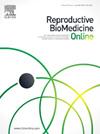COMPARISON OF PREGNANCY ACHIEVEMENT IN DAY 7 EMBRYOS WITH NGS DEPENDING ON AGE
IF 3.7
2区 医学
Q1 OBSTETRICS & GYNECOLOGY
引用次数: 0
Abstract
Objective
After the fertilization stage, extending embryo culture (blastocyst culture) until day 5 may be the most appropriate and alternative way to select embryos for transfer. Extending embryo developmental follow-up until day 5/6 is a selection tool to select embryos with a higher probability of implantation rather than improving embryo quality. The developmental potential of D5, D6 and D7 blastocysts gradually decreases with increasing culture time. Therefore, the traditional practice in the laboratory is to select embryos for transfer, biopsy or cryopreservation at D5/D6. Studies on D7 blastocysts are very limited and controversial. Clinically, in some patients, if blastocysts cannot form at D5/D6 due to poor embryo quality due to advanced maternal age or other reasons, they can be cultured until D7. Therefore, the use of slowly developing D7 blastocysts will be of great importance for these patients.
Materials and methods
This is a retrospective study planned to monitor paternal and maternal age, preimplantation genetic diagnosis/screening results and pregnancy status of patients who came for IVF treatment during the 7th day embryo development process.
Results
84 embryos of 73 patients who came to Bahçeci Umut IVF Center and completed their development on the 7th day and were frozen by NGS were included in the study. NGS results of 14 patients were normal, NGS results of 54 patients were abnormal, DNA was not detected in 2 patients, and biopsy was performed on 2 patients but was not performed upon the patient's request. Of the 15 female patients who were <35; 8 out of 17 embryos were abnormal (%47,05), 7 were normal (%41,17) and 2 embryos were biopsied for genetic processing but were not studied (%11,76). The results of 7 patients were abnormal (%46,7), the results of 6 patients were normal (%40) and 2 patients did not have biopsies taken for NGS and the material was not studied (%13,3). Of the 6 patients, 2 patients whose genetic screening results were normal had negative pregnancy results, but 2 patients were found to have pregnancies. 2 patients did not transfer their embryos despite the results. Of the 58 female patients who were >35; 53 embryos out of 67 embryos of 58 patients were abnormal (%79,1), 12 embryos were normal (%17,9) and DNA was not detected in 2 embryos (%2,98). The results of 9 patients were normal (% 15,5), 47 patients were abnormal (% 81) and DNA was not detected in 2 patients (%3,44). Of the 5 patients with normal NGS results (%55,5), 2 had live births (% 40) and 2 had miscarriages (% 40). In the 4 patients with normal NGS results, pregnancy did not occur after embryo transfer (%45).
Conclusions
In slowly developing embryos, when developmental follow-up is performed until Day 7, embryo transfer should definitely be planned with NGS. In older women (>35 years old), if the embryo has completed its development on Day 7, planning normal embryo transfer with NGS may affect the live birth rate.
求助全文
约1分钟内获得全文
求助全文
来源期刊

Reproductive biomedicine online
医学-妇产科学
CiteScore
7.20
自引率
7.50%
发文量
391
审稿时长
50 days
期刊介绍:
Reproductive BioMedicine Online covers the formation, growth and differentiation of the human embryo. It is intended to bring to public attention new research on biological and clinical research on human reproduction and the human embryo including relevant studies on animals. It is published by a group of scientists and clinicians working in these fields of study. Its audience comprises researchers, clinicians, practitioners, academics and patients.
Context:
The period of human embryonic growth covered is between the formation of the primordial germ cells in the fetus until mid-pregnancy. High quality research on lower animals is included if it helps to clarify the human situation. Studies progressing to birth and later are published if they have a direct bearing on events in the earlier stages of pregnancy.
 求助内容:
求助内容: 应助结果提醒方式:
应助结果提醒方式:


